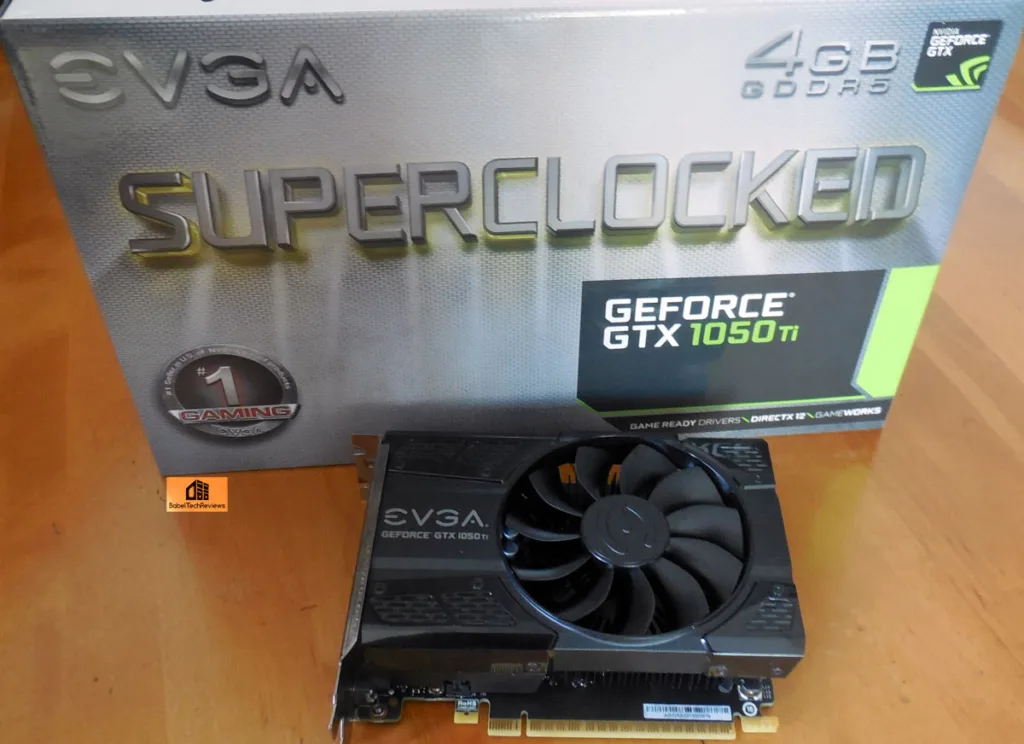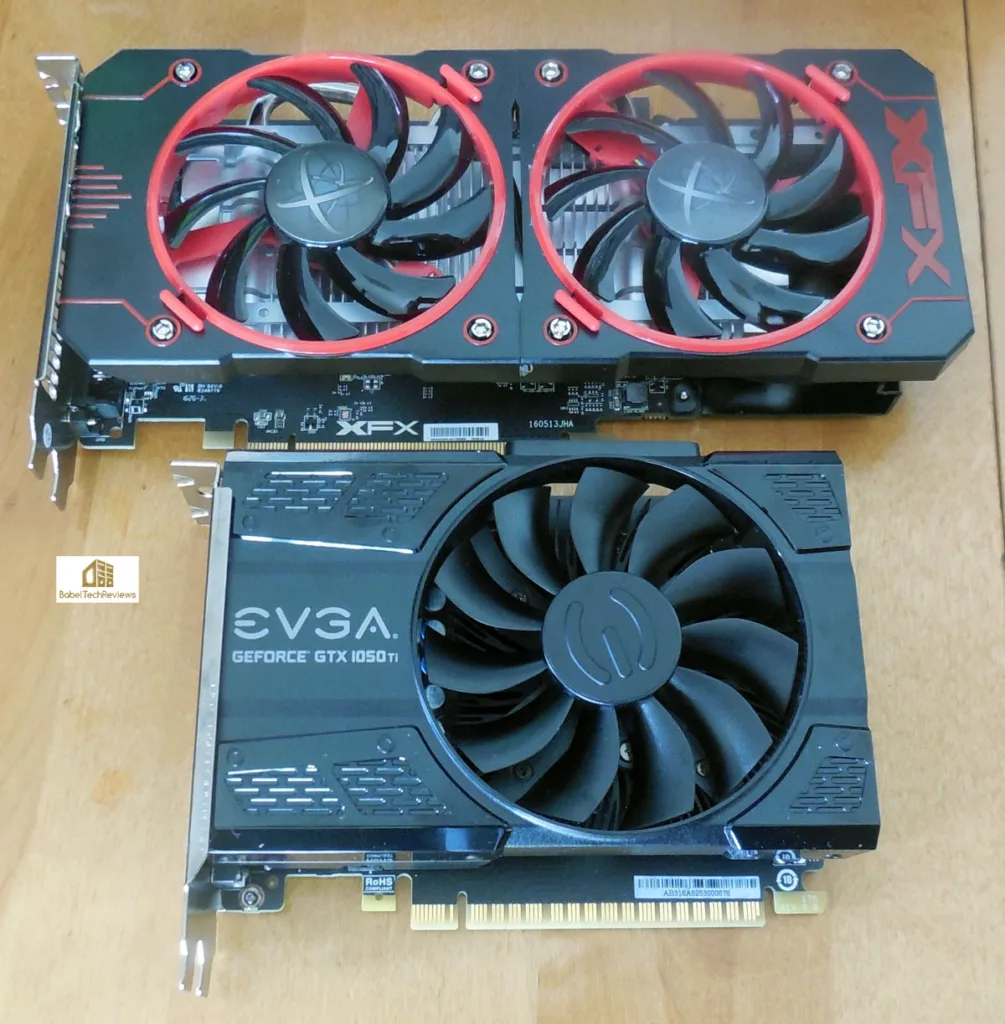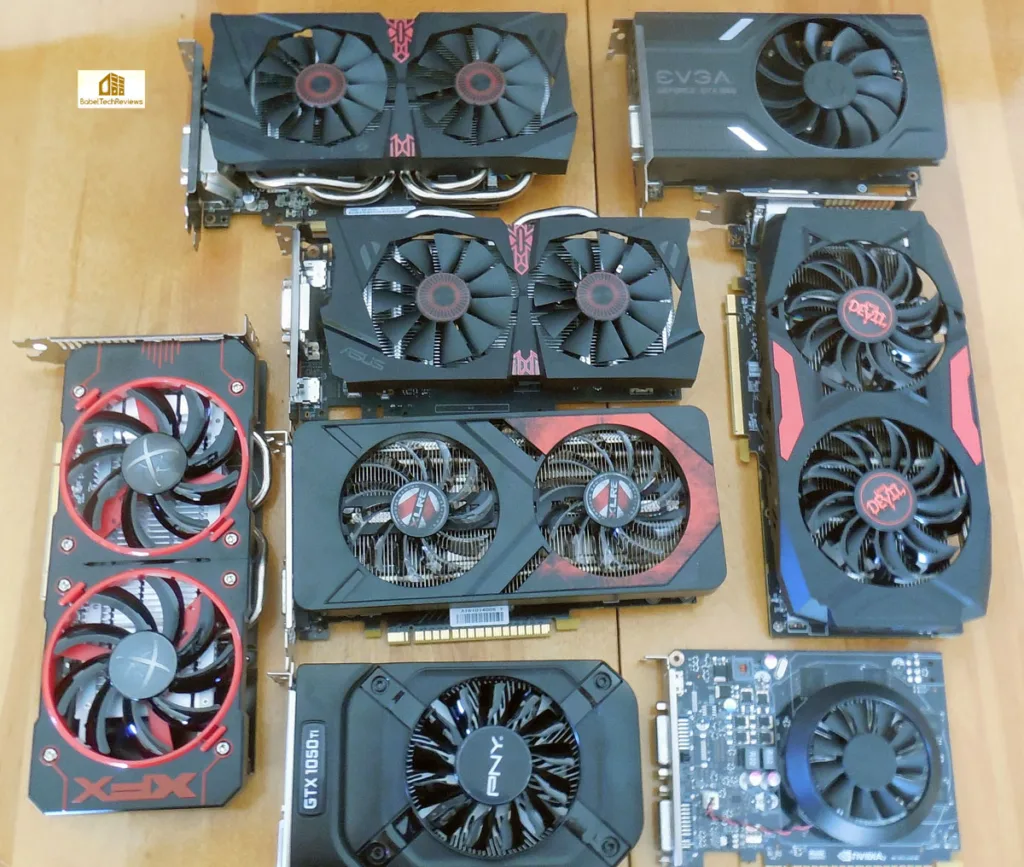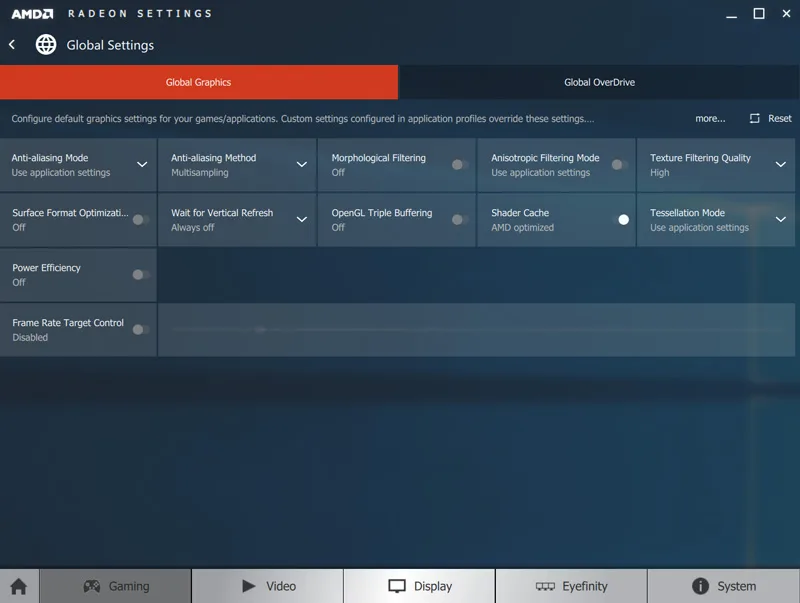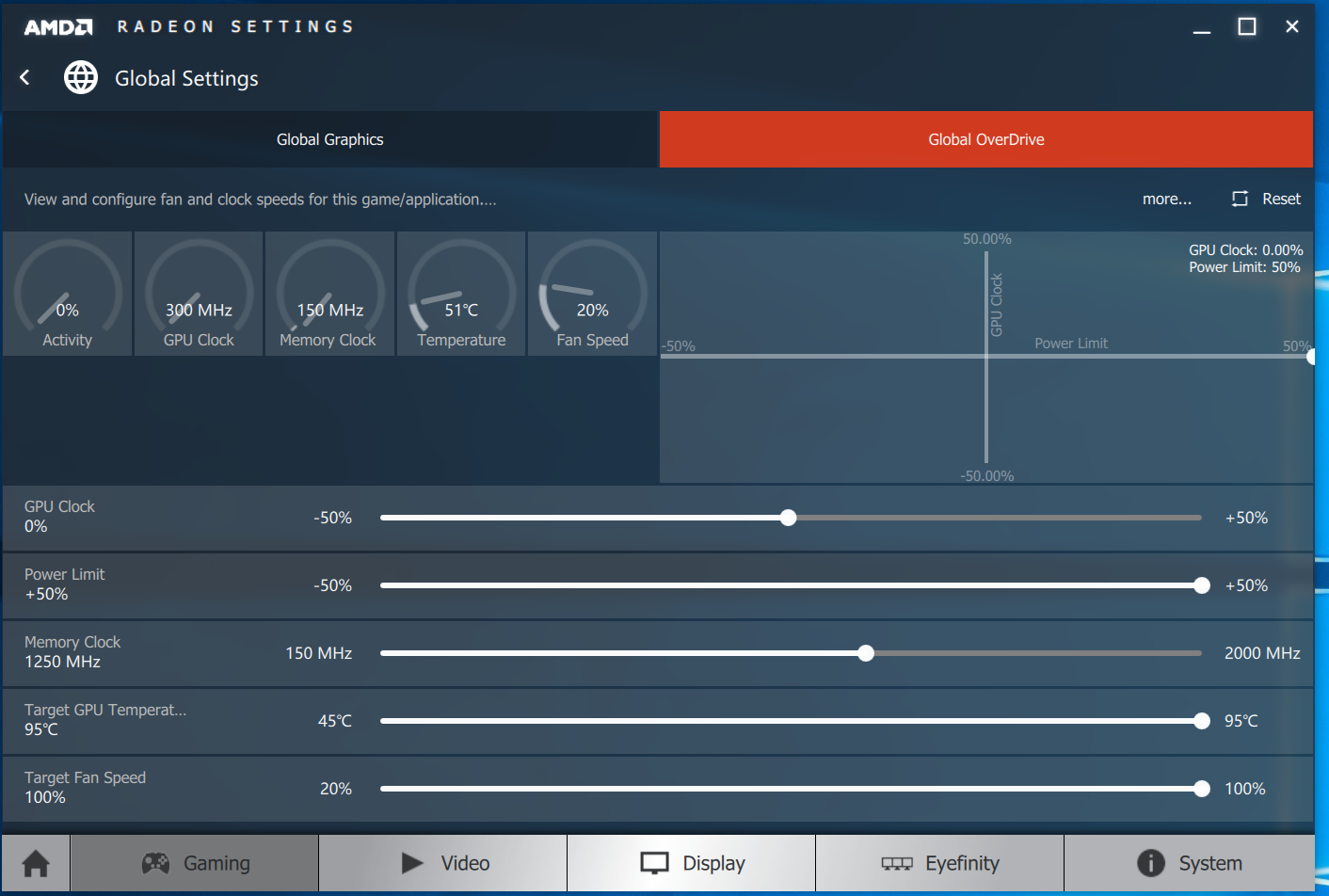On Tuesday, Nvidia launched their new Pascal GPU GP107 as the GTX 1050 and the GTX 1050 Ti which are designed to take on the AMD Radeon RX 460. GP107 is a lower-end GPU designed for 1920×1080 resolution and for gamers who are on a tight budget. We received a $149 EVGA GTX 1050 Ti Superclocked (SC) Edition from EVGA the day after the GTX 1050 Ti launch review focusing on two PNY cards was posted. The EVGA GTX 1050 Ti SC is a factory overclocked card that comes without a PCIe connector which makes it especially well-suited for upgrading low power PCs.
The AMD Polaris RX 460 arrived in August as a 2GB or 4GB 75W card on 14nm FinFET that now sells beginning at $99, depending on its vRAM capacity and core speeds. AMD has concentrated on launching the medium to low end while Nvidia began with the high end GTX 1080 and has moved down to the low end. For a recap of Nvidia’s Pascal architecture see our GTX 1060 Founders Edition launch article.
We are going to focus on the EVGA GTX 1050 Ti SC’s performance against our factory overclocked XFX RX 460 4GB card which we bought from Newegg last week and which now sells for $139.99. We are also going to compare the EVGA GTX 1050 TI SC against the two PNY GTX 1050 Tis that we already evaluated, for a total of nine competing cards to determine where it fits in terms of performance vs pricing.
Our testing platform is Windows 10 Home 64-bit, using an Intel Core i7-6700K at 4.00GHz which turbos to 4.4GHz for all cores as set in the ASRock Z7170 motherboard’s BIOS, and 16GB of Kingston DDR4 at 3333MHz. The settings and hardware are identical except for the drivers being tested.
We test 28 games and 2 synthetics featuring our newest 2016 games, Shadow Warrior 2 and Civilization VI, and we are also including Ashes of the Singularity, Hitman, Total War Warhammer, Deus Ex Mankind Divided, Gears of War 4, and Rise of the Tomb Raider using DX12. We also use Futuremark’s DX12 benchmark, Time Spy, and will compare gaming performance with maximum settings at 1920×1080.
Here is our test bed:
- EVGA GTX 1050 Ti SC – $149
- PNY GTX 1050 Ti XLR8 OC Edition – $159
- PNY GTX 1050 Ti 4GB – $149
- EVGA GTX 1060 3GB – $199
- ASUS Strix GTX 960 OC 2GB – $169
- ASUS Strix GTX 950 OC 2GB – $137
- GTX 750 Ti – $99
- XFX RX 460 4GB – $139
- PowerColor Red Devil RX 470 4GB – $184
The $149 EVGA GeForce GTX 1050 Ti SC vs. the $139 XFX RX 460
The EVGA GeForce GTX 1050 Ti is quite small when compared with its competitor, the XFX RX 460. One fan serves the EVGA GTX 1050 Ti SC, whereas the XFX RX 460 uses two fans. The EVGA GeForce GTX 1050 Ti SC is an excellent choice for the home theater PC (HTPC) or the small form factor (SFF) PC enthusiast, and it is an outstanding choice for a low power PSU as it does not use a PCIe cable but rather draws all of its power – up to 75W – from the PCIe slot. Since the XFX RX 460 requires a 6-pin PCIe cable, we will also attempt to determine if the EVGA GTX 1050 Ti is held back by its having no PCIe cable.
The EVGA GTX 1050 Ti SC Gaming Edition
The EVGA GeForce GTX 1050 Ti SC Gaming edition video card featuring EVGA ACX 2.0 cooling has arrived with a retail price of $149.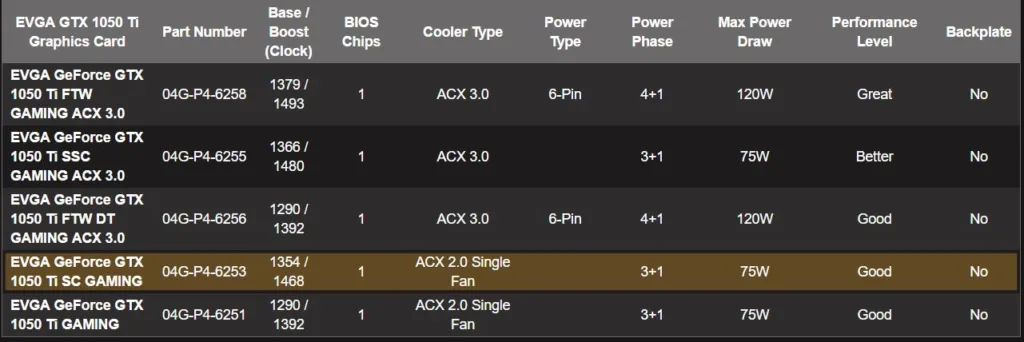
This EVGA GTX 1050 Ti SC Gaming is clocked at 1354MHz base/1468 Boost which is clocked above the lowest two of the five GTX 1050 Ti EVGA models which range in price from $145 to above $159. It has a basic 3+1 Power Phase design and it draws all of its power from the PCIe slot compared with the more expensive models which feature more robust power delivery and better cooling systems. The SC costs $5 more than the base EVGA GTX 1050 Ti which is reference clocked at 1290MHz base/1392MHz boost.
All EVGA GTX 1050 Ti cards feature ACX fan technology with optimized swept blades, double ball bearings and a low-power motor that delivers more air flow with less power, unlocking additional power for the GPU. The fan will even shut down when the card is not under load.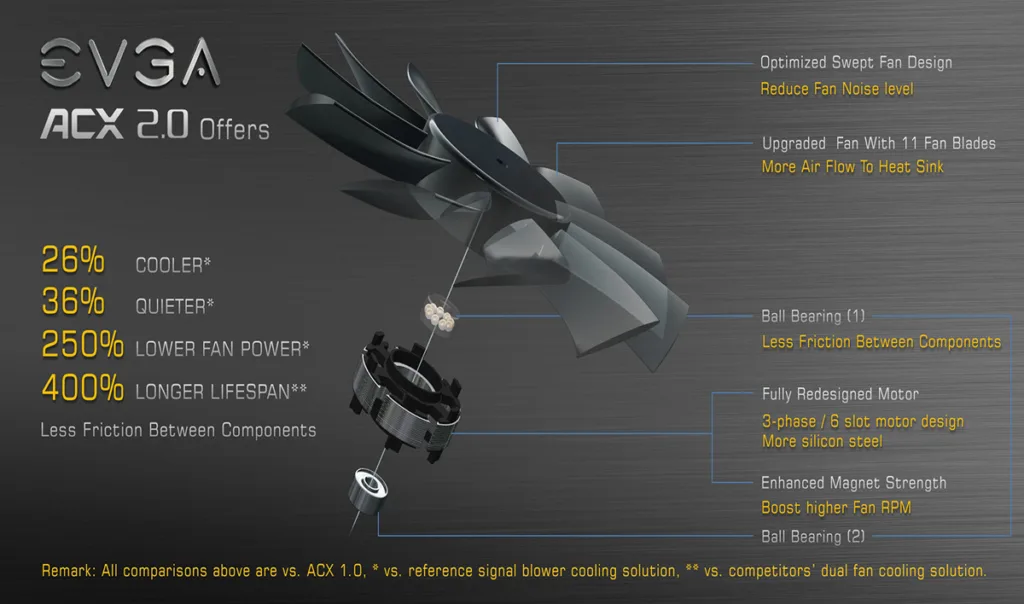
Features & Specifications of EVGA’s GeForce GTX 1050 Ti SC Gaming Edition:
Here are Nvidia’s specifications for the reference GTX 1050 Ti: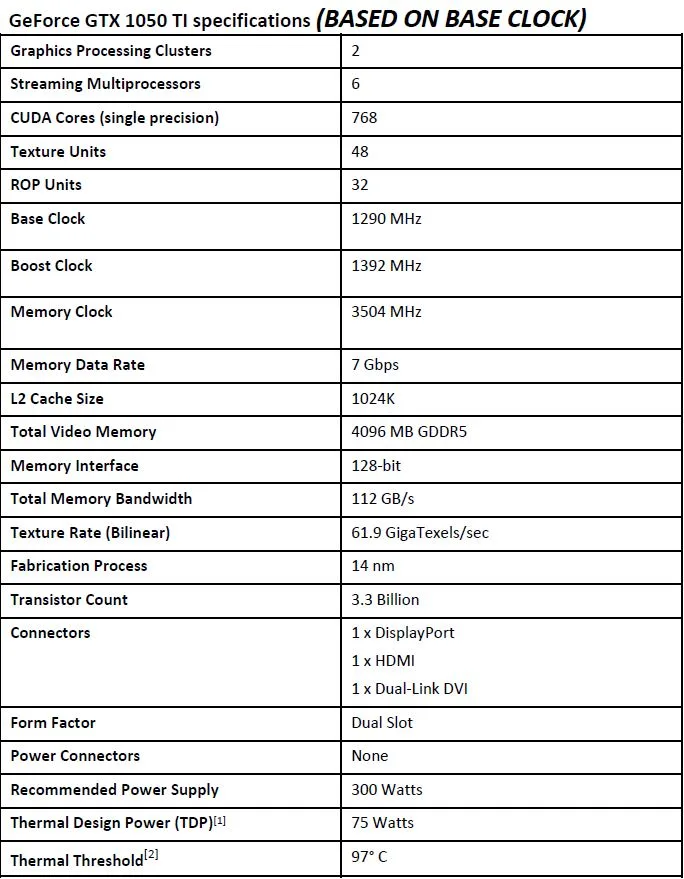
Here are the specifications and the details for the EVGA GTX 1050 Ti SC Gaming edition.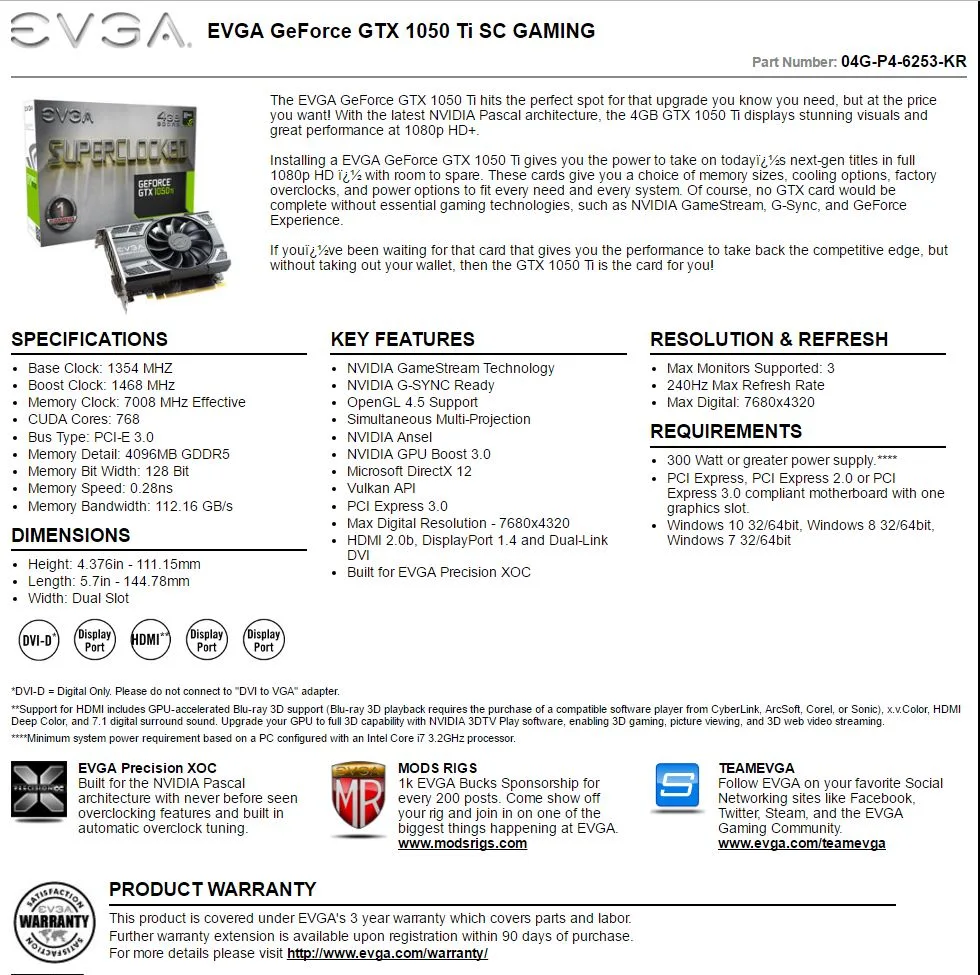
The EVGA GTX 1050 Ti SC’s base clock is 1354MHz which is 64MHz above reference, and the Boost clock is 1468MHz or 76MHz above reference. The minimum boost we actually saw is above 1632MHz and we were able to add +175MHz to the core in our preliminary overclock! Since the GDDR5 memory is not further overclocked by EVGA, we found that we also gained some impressive performance by overclocking the memory clocks +400MHz.
From what we have seen, the specifications of the EVGA GTX 1050 Ti SC Gaming Editon are impressive for a $149 video card, and our sample clocked significantly higher than the guaranteed clocks.
Our EVGA GTX 1050 Ti SC Gaming Edition came directly from EVGA to BTR as a sample. EVGA wants to make it very clear that what they sent us is the same as what you can buy from any etailer. EVGA sent out this press release:
EVGA was one of the first graphics card companies to offer overclocked graphics cards, and since day one EVGA always delivered the exact same products to reviewers as well as customers. EVGA does not “fake” reviews or send out products with “tweaked” clockspeeds to reviewers. With EVGA Superclocked, FTW and Classified graphics cards, what you see is what you get.
Buyers are covered by EVGA’s 3-year warranty with a further warranty extension available upon registration within 90 days of purchase.
EVGA PrecisionX OC Unlocks automatic overclocking
Our preliminary overclock of +175MHz to the core appears to be stable and it looks pretty good so far, and we will follow up this evaluation with an overclocked-to-the-max EVGA GTX 1050 Ti versus the manually overclocked PNY GTX 1050 Tis and versus the overclocked to the max XFX RX 460 4GB to see which card ultimately delivers the highest performance.
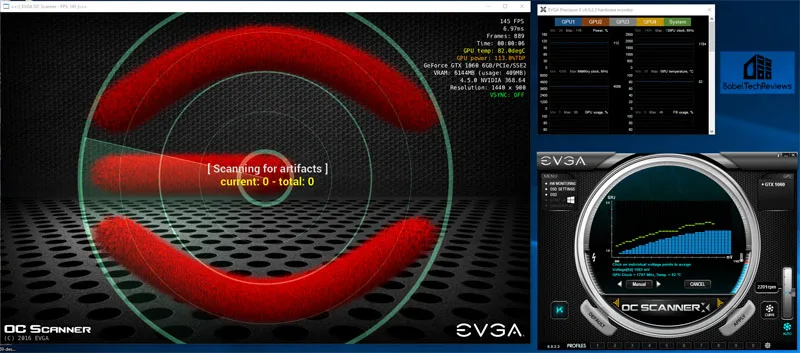 The EVGA PrecisionX OC works with Pascal architecture and now combines manual and automatic overclock tuning features to give the end user more options.
The EVGA PrecisionX OC works with Pascal architecture and now combines manual and automatic overclock tuning features to give the end user more options.
Includes Exclusive Features for EVGA GeForce GTX 1050 Ti SC:
- DirectX 12 OSD Support – See the on screen display on DirectX 12 games.
- EVGA OC ScannerX Integration – Automatically find your optimal voltage/frequency curve!
- K-Boost Function – Maximize your clocks with this exclusive feature.
Learn more here.
Let’s take a closer look at the new EVGA GTX 1050 Ti SC Gaming Edition.
Unboxing the EVGA GTX 1050 Ti SC Gaming Edition
The EVGA GTX 1050 Ti SC comes in a small box that advertises that EVGA is Nvidia’s No. 1 seller in the USA. The box features the GTX 1050 Ti SC’s 4GB GDDR5, and that it is ready for Game Ready drivers/GameWorks/DX12.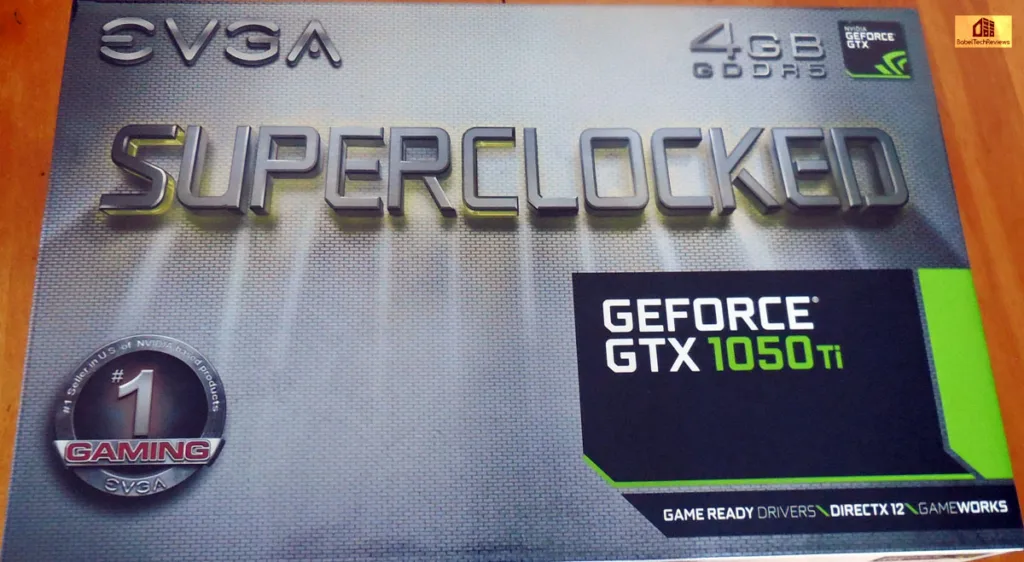
The sides and back of the box are printed in several languages that advertise its key features, as well as emphasize the EVGA warranty and PrecisionX OC.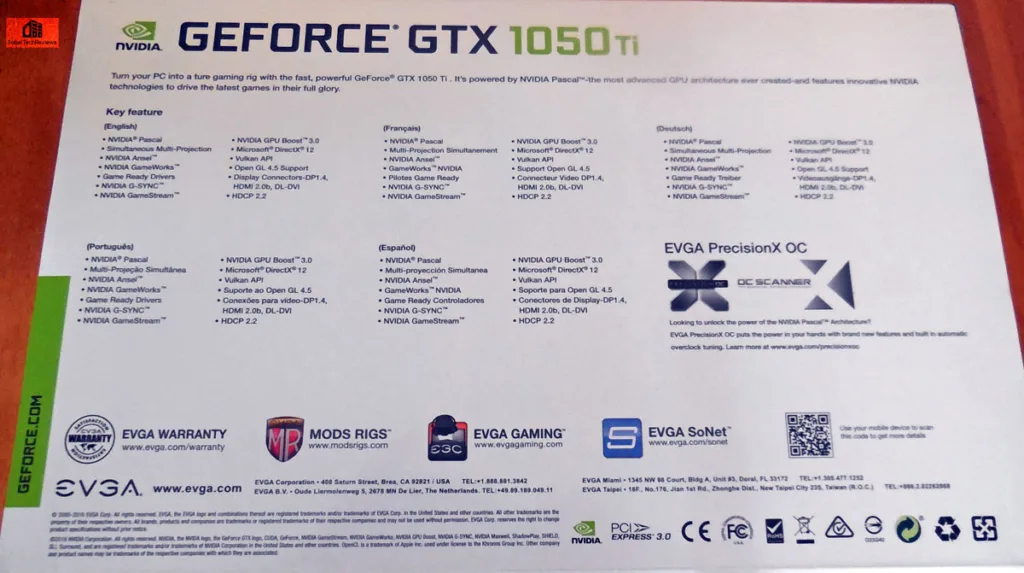
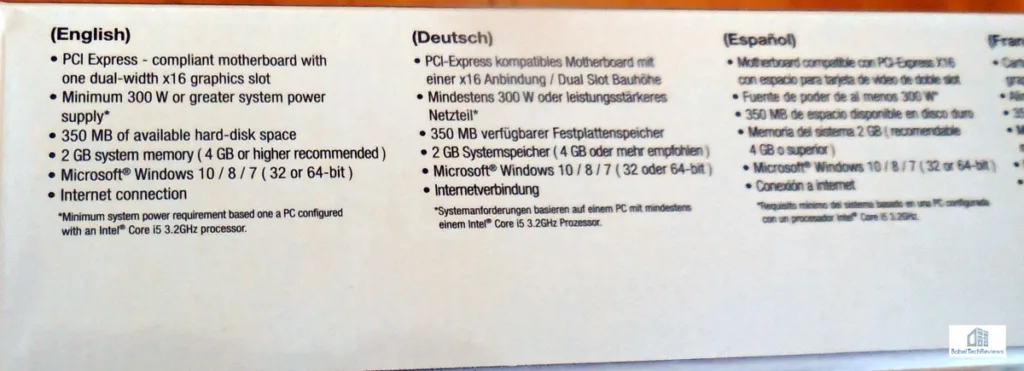 Here is everything out of the box. The card is packed securely and it comes in an anti-static bag. It comes with an EVGA badge, a user and an installation guide.
Here is everything out of the box. The card is packed securely and it comes in an anti-static bag. It comes with an EVGA badge, a user and an installation guide.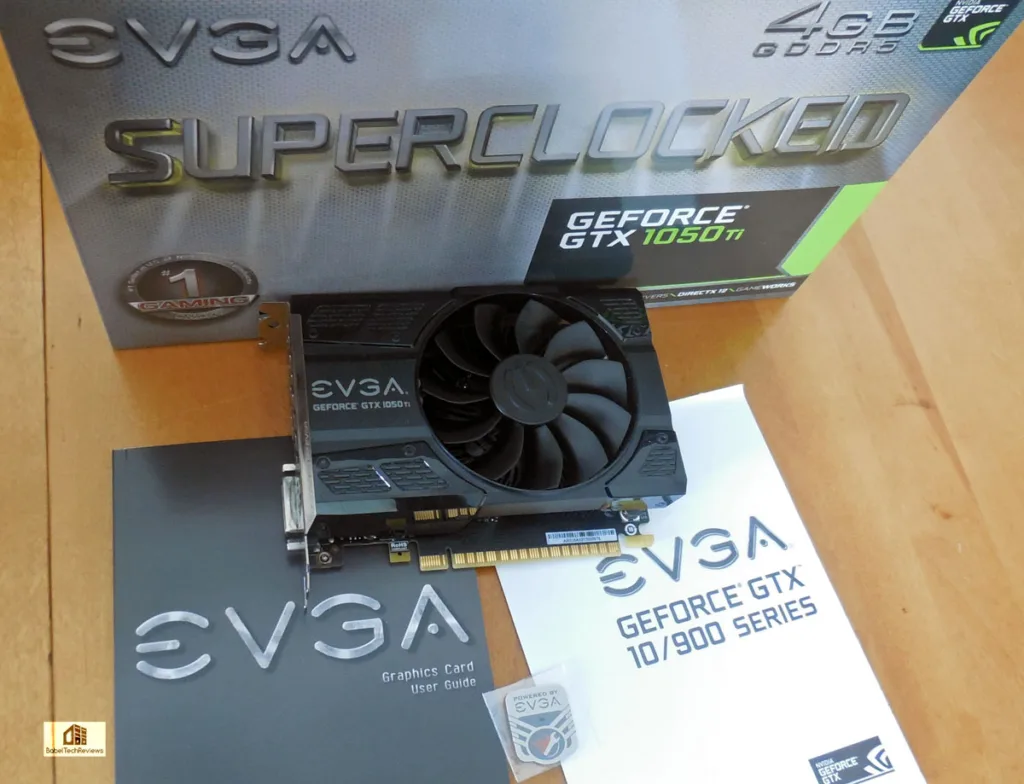
The EVGA GTX 1050 Ti SC is a handsome short single-fan card that covers a heatsink. The large fan spins relatively slowly and it never needed more than 40% fan speed to stay below 66C. A slower-turning ACX 2.0 fan will remove the GPU heat better and more quietly, compared with a double speed single blower-style fan. The ACX 2.0 fan is very quiet and we never needed to turn it up as our GPU never got hot even under maximum overclocking.
We turn the card on its edge and look at the slim design cooling fins which allow the card to fit into a PC motherboard’s double slot configuration. The heatsink area is quite large for a very small card. All of the power is drawn from the PCIe slot, there is no PCIe connector.
The heatsink area is quite large for a very small card. All of the power is drawn from the PCIe slot, there is no PCIe connector.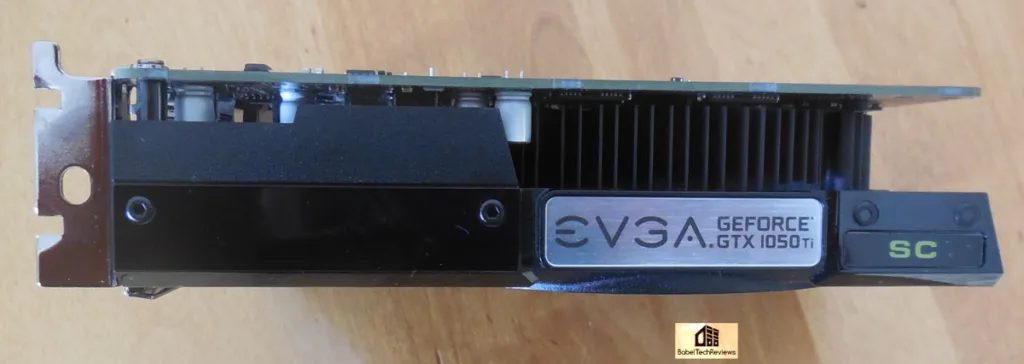
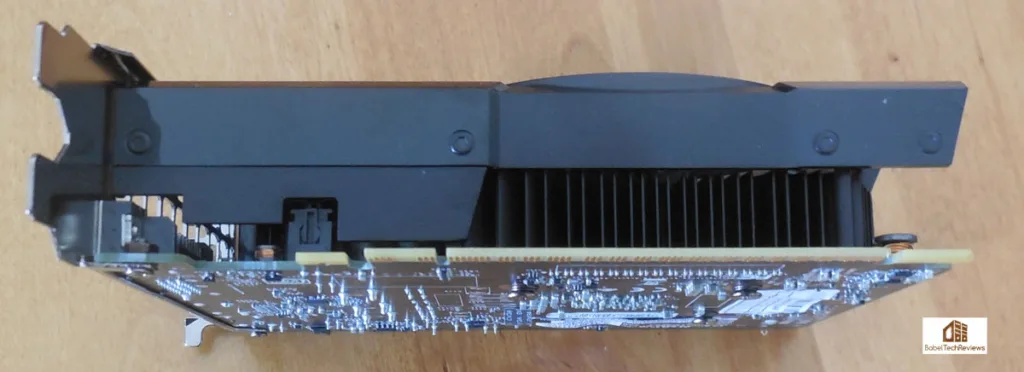

None of EVGA’s GTX 1050 Ti video cards have a backplate.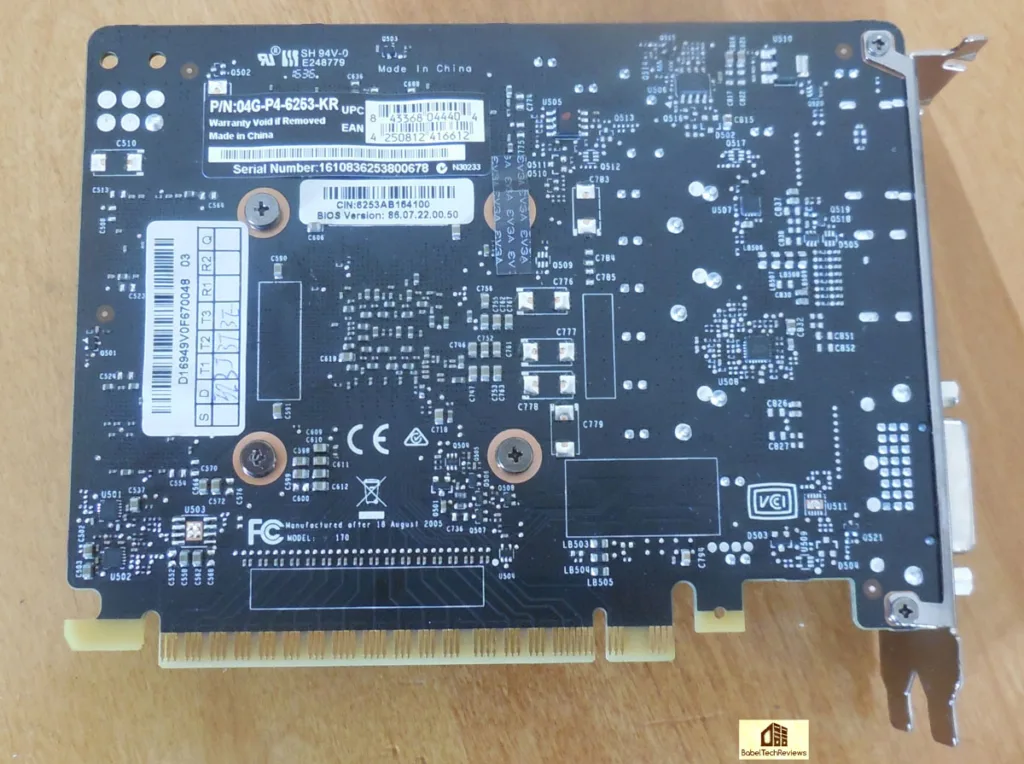
Here is the connector panel.There are one dual link DVI port, 1 Display Port and a HDMI 2.0 port. The EVGA GTX 1050 Ti comes with covers for the connectors.
The EVGA GTX 1050 Ti SC Gaming edition is a handsome small card and the specifications look very good. Let’s check out its performance versus the competing cards after we look over our test configuration on the next page.
Test Configuration – Hardware
- Intel Core i7-6700K (reference 4.0GHz, HyperThreading and Turbo boost is on to 4.4GHz; DX11 CPU graphics).
- ASRock Z7170M OC Formula motherboard (Intel Z7170 chipset, latest BIOS, PCIe 3.0/3.1 specification, CrossFire/SLI 8x+8x)
- HyperX 16GB DDR4 (2x8GB, dual channel at 3333MHz), supplied by Kingston
- EVGA GTX 1050 Ti SC Gaming edition, EVGA clocks, supplied by EVGA
- PNY GTX 1050 Ti XLR8 Overclocked edition 4GB, PNY clocks, supplied by PNY
- PNY GTX 1050 Ti 4GB, reference clocks, supplied by PNY
- EVGA GTX 1060 3GB, stock clocks, supplied by EVGA
- ASUS Strix GTX 950 GB OC 2GB, ASUS factory clocks, supplied by ASUS
- ASUS Strix GTX 960 GB OC 2GB, ASUS factory clocks, supplied by ASUS
- GTX 750 Ti, 2GB, reference clocks, supplied by Nvidia
- XFX RX 460 4GB, XFX factory clocks
- PowerColor Red Devil RX 470 4GB, at PowerColor factory clocks, supplied by PowerColor
- Two 2TB Toshiba 7200 rpm HDDs for each platform
- EVGA 1000G 1000W power supply unit
- Thermaltake Water2.0, supplied by Thermaltake
- Onboard Realtek Audio
- Genius SP-D150 speakers, supplied by Genius
- Thermaltake Overseer RX-I full tower case, supplied by Thermaltake
- ASUS 12X Blu-ray writer
- Monoprice Crystal Pro 4K
Test Configuration – Software
- Nvidia’s GeForce GTX 1050 Ti launch driver 375.57 used for all of the Nvidia cards except for the EVGA GTX 1050 Ti which used the WHQL GeForce Driver 375.63 providing identical performance. High Quality, prefer maximum performance, single display.
- AMD Crimson Software 16.10.2 drivers were used for benching AMD cards.
- VSync is off in the control panel.
- AA enabled as noted in games; all in-game settings are specified with 16xAF always applied
- All results show average frame rates including minimum frame rates shown in italics on the chart below the averages.
- Highest quality sound (stereo) used in all games.
- Windows 10 64-bit Home edition, all DX11 titles were run under DX11 render paths. Our four DX12 titles are run under the DX12 render path. Latest DirectX
- All games are patched to their latest versions at time of publication.
- Crimson Software’s WattMan was used for the RX 460 and the RX 470 to set the Power Limits to maximum.
- EVGA’s Precision XOC, latest beta version (supplied by EVGA) used for Nvidia cards to set the overclock and the Power/Temp targets to maximum.
- Unigine Heaven 4.0 was used to set preliminary overclocks
Synthetic
- Firestrike – Ultra & Extreme
- Time Spy DX12
DX11
- Crysis 3
- Metro: Last Light Redux (2014)
- Middle Earth: Shadows of Mordor
- Alien Isolation
- Dragon’s Age: Inquisition
- Dying Light
- Grand Theft Auto V
- ProjectCARS
- the Witcher 3
- Batman: Arkham Origins
- Mad Max
- Fallout 4
- Star Wars Battlefront
- Assassin’s Creed Syndicate
- Just Cause 3
- Rainbow Six Siege
- DiRT Rally
- Far Cry Primal
- Tom Clancy’s The Division
- Mirror’s Edge Catalyst
- Shadow Warrior 2
- Civilization VI
DX12 Games
- Ashes of the Singularity
- Hitman
- Rise of the Tomb Raider
- Total War: Warhammer
- Deus Ex Mankind Divided
- Gears of War 4
Nvidia’s Control Panel settings:
Here are the settings that we always use in AMD’s Crimson Control Center for our default benching. The Power Efficiency Toggle is left off in our benching.
Let’s head to the performance charts to primarily see how the stock EVGA GTX 1050 Ti SC Gaming edition compares with the XFX RX 460 and with the stock-clocked PNY GTX 1050 Ti card, as well as compared with our other cards in the test bed.
Overclocking the EVGA GTX 1050 Ti SC Gaming Edition
We did not run the overclocked benchmarks of the EVGA GTX 1050 Ti SC Gaming edition yet. We will follow up this weekend with an overclocking evaluation versus the overclocked XFX RX 460 and against the PNY GTX 1050 Tis. Overclocking the Pascal GTX 1050 Tis are not as quite easy as overclocking Maxwell architecture-based cards. We have overclocked the Founders Edition of the GTX 1060 using PrecisionX OC and you can read about methods and our results here as they are very similar to overclocking all Pascal cards.
We learned that experienced overclockers won’t want to bother with the PrecisionX OC scanner at all – except perhaps to rough in a quick overclock as a starting point. The main thing to remember if you want as high an overclock as possible is to turn the voltage up to maximum, set the fan profile to “aggressive” or to 100%, and go from there.
You also need to remember that Pascal overclocking is highly temperature dependent. Keep your GPU cool and you will max out your overclock. Adding voltage is secondary – it only moves the limit up a bit – as the GPU’s BIOS controls it automatically, and it is best used to stabilize a marginal overclock. In this particular case the EVGA GTX 1050 Ti SC Gaming edition does not run hot and even our maximum preliminary overclock of adding +175MHz to the core and +400MHz to the memory did not raise the GPU temperature above 66C!
These are the clocks that we get just above idle with everything set completely to stock with the Power/Temp Targets set to maximum. We originally had some issues with the Temperature Target not keeping its settings after PrecisionX OC was closed. To work around this issue, simply unlink the Power from the Temperature Target.
The EVGA GTX 1050 Ti SC’s base clock is 1354MHz which is 64MHz above reference, and the Boost clock is 1468MHz or 76MHz above reference. The minimum boost we actually saw is above 1632MHz and we were able to add an additional 175MHz to the core in our preliminary overclock!
Since the GDDR5 memory is not further overclocked by EVGA, we found that we also gained some impressive performance by overclocking the memory clocks +400MHz. Below are the results of looping Heaven 4.0 for an hour at completely stock settings in a warm room (79F). The GPU clock boosts above 1632MHz.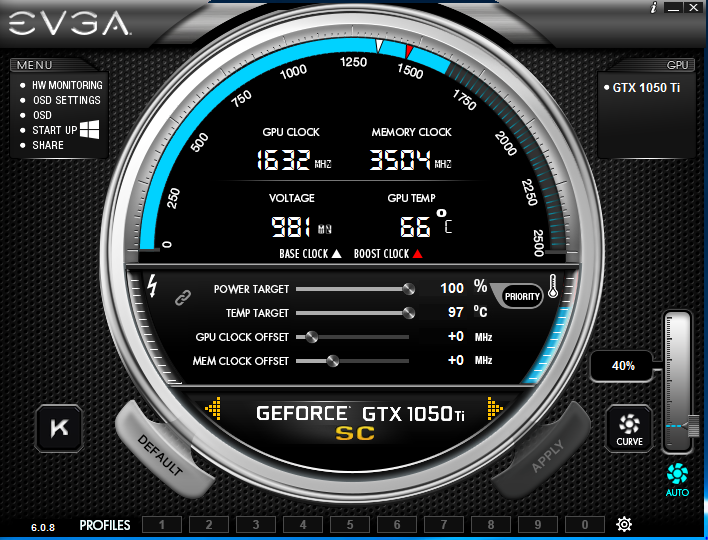
After spending hours incrementally overclocking our EVGA GTX 1050 Ti SC Gaming edition we settled on our maximum preliminary overclock.of 175MHz offset to the core clock. The resulting Boost that we observed peaked at 1898MHz but dropped and fluctuated between 1835MHz and and 1873MHz when we added 175MHz to EVGA’s already overclocked core. Please note that this is just a preliminary overclock and that we will continue to test it for stability and performance increases. We found it strange that the temperature did not increase with the overclock and will test it further to make sure the overclock was applied properly by PrecisionX.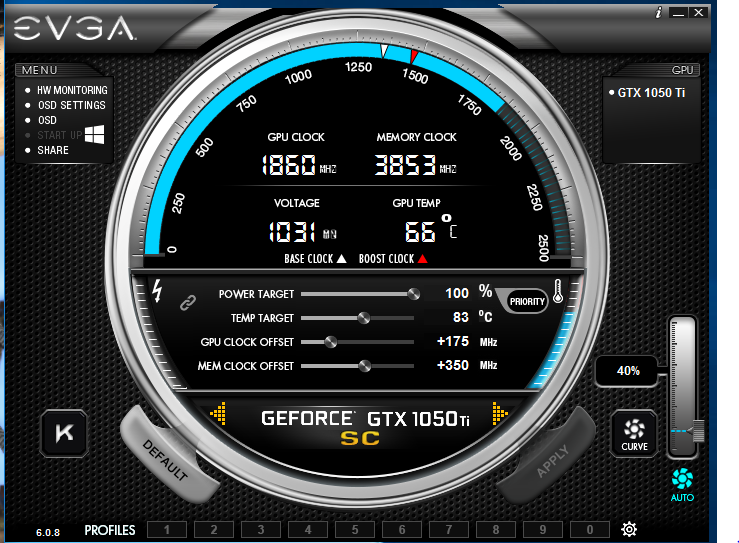
Since the GDDR5 memory is not further overclocked by EVGA, we found that we gained some impressive performance by overclocking the memory clocks +400MHz, to 3903MHz. These are the preliminary clocks that we set for our EVGA GTX 1050 Ti SC Gaming edition and we shall follow up with its performance results versus the overclocked XFX RX 460 and versus our PNY GTX 1050 Tis in a follow-up evaluation.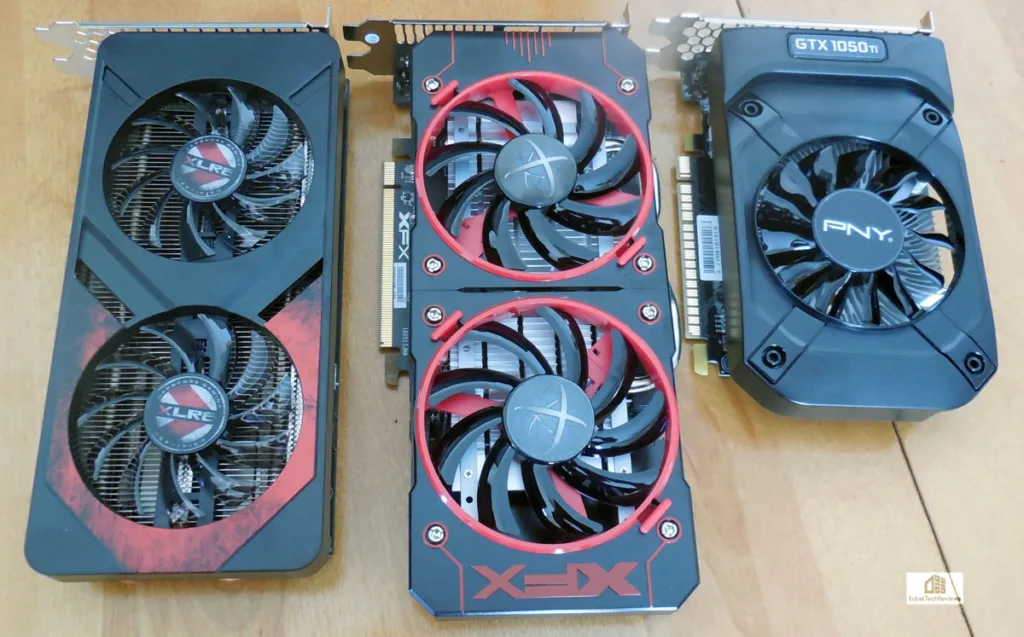 You can download PrecisionX directly from here where you can download it for free.
You can download PrecisionX directly from here where you can download it for free.
Lets see how the EVGA GTX 1050 Ti SC Gaming edition compares with the XFX RX 460, and with other competing cards of Autumn, 2016.
Performance summary charts
All of our testing is at 1920×1080 resolution for which these cards were designed. To be consistent across all of our benching, we use maximum settings. All results except for Firestrike and Timespy are expressed in average fps (in Bold) and also generally in minimum fps (where they make sense, in italics below the averages).
The stock EVGA GTX 1050 Ti SC performance results are in Column 1 and it’s main competitor the XFX RX 460 4GB OC version performance results are in the second column. The third column shows the performance of the reference PNY GTX 1050 Ti 4GB, with the fourth column devoted to the PNY GTX 1050 Ti XLR8 Overclocked Gaming edition results. The fifth column shows the reference GTX 750 Ti results. The sixth and seventh columns show the performance of the last generation ASUS Strix GTX 950 OC and the ASUS Strix GTX 960 OC results, and the eighth and ninth columns compare the PowerColor-clocked RX 470 with the reference clocked EVGA GTX 1060 3GB.
Make sure to open this chart in another window or in a separate tab for better readability.




 As you can see, the factory-clocked $149 EVGA GTX 1050 Ti SC blows away the $139 factory clocked XFX RX 460. It isn’t even close except in Deus Ex Mankind Divided. We also see that the $159 PNY GTX 1050 Ti XLR8 OC Gaming edition is faster than the EVGA GTX 1050 Ti SC, and the performance gap widens over the XFX RX 460 which is also a factory overclocked card.
As you can see, the factory-clocked $149 EVGA GTX 1050 Ti SC blows away the $139 factory clocked XFX RX 460. It isn’t even close except in Deus Ex Mankind Divided. We also see that the $159 PNY GTX 1050 Ti XLR8 OC Gaming edition is faster than the EVGA GTX 1050 Ti SC, and the performance gap widens over the XFX RX 460 which is also a factory overclocked card.
The older generation GTX 950 card, although factory overclocked by ASUS, are easily bested by even the reference GTX 1050 Ti as the GTX 960 OC is generally bested by the EVGA GTX 1050 Ti SC and the PNY GTX 1050 Ti XLR8. We see the GTX 750 Ti – a very popular low power card which is still priced at around $99 – is really showing its age and we think the new GTX 1050 Ti which is just as low power, will make a very good upgrade for gamers with small capacity PSUs.
The stock clocked EVGA GTX 1060 3GB and the PowerColor clocked Red Devil RX 470 are in a higher class entirely as they are priced in the $185-$200 range. However, if you can afford to spend the extra money and have a suitable power supply unit, you will get significantly greater performance than with either a GTX 1050 Ti or with a RX 460.
Let’s head for our conclusion.
The Conclusion
We have no trouble giving a big recommendation to the EVGA GTX 1050 Ti SC at the same $149 as the stock-clocked PNY GTX 1050 Ti. Both cards are small, they look great, run cool and are very quiet, and their out of the box performance is significantly higher than the competing XFX RX 460 for about the same price. The EVGA GTX 1050 Ti SC win all of our benchmarks over the RX460 and the reference clocked PNY GTX 1050 Ti 4GB card.
The primary reason in our opinion to choose the $149 EVGA GTX 1050 Ti SC version over the $159 XLR8 is if you need a shorter card that does not require a PCIe connector. Other than that, we would probably pick the XLR8 for its higher performance and likely better overclocking potential for ten dollars more. We would not choose a 2GB card any longer for even 1920×1080 as we see our older GTX 960 and GTX 950 have issues with some modern games because of their limited vRAM capacities.
One thing to note, if you can afford to spend the extra $35 to $50 and you have a suitable power supply unit, you will get significantly greater performance with a GTX 1060 3GB or a RX 470 than with any GTX 1050 Ti. The GTX 1050 Ti is intended by Nvidia as an 75W upgrade for the GTX 750 Ti which is still selling for around $100 because of its popularity as a low-power card that doesn’t require a PCIe cable. In this regard, the GTX 1050 Ti is significantly more powerful than the older card.
We did not get to overclock any of our GTX 1050 Tis for a performance comparison because of the very limited time we had to evaluate them, and we will follow up later this week with a manual overclocking evaluation comparing EVGA GTX 1050 Ti SC with both of our PNY cards and with the XFX RX 460. We expect that the XLR8 version will overclock better than the standard EVGA GTX 1050 Ti SC by virtue of its better cooling and higher power draw potential by using a 6-pin PCIe cable.
EVGA GTX 1050 Ti SC Pros
- The EVGA GTX 1050 Ti SC soundly beats the XFX RX 460 overall in performance at a similar price. It is faster than the PNY GTX 1050 Ti 4GB reference clocked card and has the same maximum 75W power draw at the same $149.
- With no PCIe connector, TDP and power draw are good and it is very quiet even when overclocked to the maximum. ACX 2.0 cooling is very effective for this card.
- Overclockability is excellent out of the box – GPU Boost 3.0 works as advertised.
- The card is well-built, looks great and fits into a smaller space than competing cards.
- The GeForce Experience and GameWorks, including ShadowPlay, enhance the gaming experience. G-SYNC helps to smooth gaming framerates by syncing the display to the GPU and it allows for smooth framerates without stuttering or tearing.
- EVGA has excellent support and a 3-year warranty.
Cons
- None
 The Verdict:
The Verdict:
- If you are buying a video card right now and looking for good performance at 1920×1080, the EVGA GTX 1050 Ti SC is an excellent choice. It beat its XFX RX 460 competition while using less power.
- We would choose the EVGA GTX 1050 Ti SC for 1920×1080 gaming where space and power considerations are tight. It is overclocked right out of the box and it has more performance than the reference clocked versions.
- We would like to award the EVGA GTX 1050 Ti SC BTR’s Great Value Award
We do not know what the future will bring, but the EVGA GTX 1050 Ti SC Gaming edition brings an excellent performer to the Pascal GeForce family, and it clearly establishes itself as having excellent value for 1920×1080 gaming especially where budget and lower power situations are important.
If you currently game on an older generation video card, you will do yourself a big favor by upgrading. The move to a EVGA GTX 1050 Ti SC will give you better visuals on the DX11 and DX12 pathways and they are both faster than the RX 460 in the same price range And we will follow this evaluation up with an overclocking evaluation.
AMD offers their own set of features including Vulkan, Eyefinity 2.0, and FreeSync, but their Polaris RX 460 as represented by the factory overclocked XFX RX 460 card, simply cannot match the performance of even a GTX 1050 Ti at stock clocks.
Stay tuned, there is a lot coming from us at BTR. We are going to put all of our competing cards GTX 1050 Ti into an Overclocked Showdown versus the XFX RX 460. We also have a HyperX Cloud Stinger headset up for evaluation this weekend.
Happy Gaming!
Mark Poppin
BTR Editor-in-Chief
